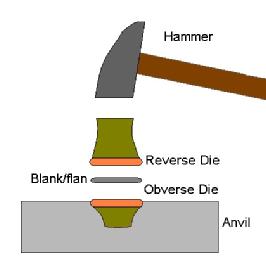Glossary
This page contains an introduction to the terminology used when studying coinage.
A coin and its parts

There is a specific terminology used by numismatists when describing a coin. Type refers to the image on a coin. The legend is any writing on the coin. The exergue is a space on the coin below the central design, usually delineated by a line. The field of a coin is the blank space surrounding the image. The obverse of a coin is usually the 'heads' side, though technically it is the side of a coin struck from the die placed in the anvil during coin production (see below). The reverse is normally the 'tails' side, or the side struck from the die held by a mint worker.
Striking coins
In antiquity coins were often produced by hand, and this process could result in imperfections.  Coins were either cast, or (more commonly) struck using two dies. A die bore the design of the coin. The obverse die was placed in an anvil, while the reverse die was held by the mint worker. A prepared piece of metal of appropriate weight (flan) was then placed between the two dies and struck.
Coins were either cast, or (more commonly) struck using two dies. A die bore the design of the coin. The obverse die was placed in an anvil, while the reverse die was held by the mint worker. A prepared piece of metal of appropriate weight (flan) was then placed between the two dies and struck.
Coin metals
In antiquity coinage could be made from electrum (EL), gold (AV), silver (AR), copper or bronze alloy (AE), brass or orichalcum (Or), or heavily leaded silver or billon (BI). The abbreviations given here are those commonly used by numismatists, and are the abbreviations used in the database.
